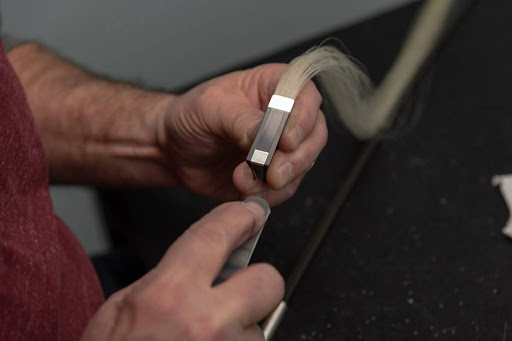Your violin bow is more than just a tool—it’s an extension of your artistry. Every detail matters, and the frog is no exception. This small but essential piece directly affects your grip, control, and even the tonal quality of your playing.
But why do you need a frog on a violin bow, and how do you choose the right one? Whether you’re refining your technique or searching for a bow that feels like a natural fit, the right frog can make all the difference. Here’s how to find the perfect one for your needs.
Why Do You Need a Frog on a Violin Bow?
If you’ve ever played with a bow that just doesn’t feel quite right, the violin frog might be the culprit.
Think of the frog as the bridge between you and your bow. It plays three major roles. It houses the mechanism that attaches the hair to your bow, adjusts the tension of the bow hair, and plays a big role in how comfortable and controlled your playing feels. Overall, a well-designed frog ensures your bowing stays fluid and natural. When you find the right one, you’ll notice the difference immediately.
How to Choose the Best Violin Bow Frog for You
There’s no universal answer to what makes the perfect frog—it depends on your personal playing style, technique, and even your aesthetic preferences. Here’s what to consider:
1. Cost: What’s Your Budget?
Your budget will also influence your choice of violin bow frog. Traditional materials like ivory or ebony are often more expensive due to their rarity and craftsmanship. Synthetic composites offer high-quality performance at an often more affordable price point.
2. Frog Material: What It’s Made Of Matters
Traditionally, violin bow frogs are crafted from ebony, a dense and durable wood favored for its stability. However, concerns over deforestation and sustainability have led to increased interest in alternative materials. Along with ebony, violinists have several choices when it comes to frog material:
- Ebony (Traditional Choice, Sustainability Concerns): While prized for its durability and aesthetic appeal, ebony is often sourced unsustainably. Ethical sourcing and conservation efforts are now a priority for many luthiers.
- Pernambuco (Historically Used, Now Highly Regulated): Though primarily used for bow sticks, Pernambuco was occasionally used for frogs. Due to its endangered status, it is now heavily restricted, and buyers should ensure legal, ethically sourced materials.
- Synthetic composites (Eco-Friendly and Reliable): These man-made materials are designed to replicate the elegance of traditional woods without contributing to unethical practices like deforestation. Synthetic composites, like those offered by CodaBow, are an eco-friendly choice that offers consistency, reliability, and longevity.
- Ivory and Tortoiseshell (Historically Used, Now Restricted): Once prized for their aesthetics, these materials are no longer widely used due to conservation efforts.
At CodaBow, we believe that sustainability and performance go hand in hand. That’s why we offer high-quality composite materials that mirror the benefits of traditional woods—while helping to conserve endangered resources. A great example is the CodaBow Xebony® Frog, which is made from a proprietary blend of natural fibers and resin that are more robust and resilient than natural ebony.
2. Weight and Balance: What Feels Right?
The frog plays a huge role in how the bow is weighted. A heavier frog can add more stability and control, which is great for orchestral or slower, more deliberate playing. Lighter frogs allow for faster, more agile movement—ideal for soloists who need quick, clean articulation. If you feel like your bowing is sluggish or too jumpy, adjusting the frog weight might be the solution.
3. Shape and Comfort: Does It Fit Your Hand?
This might be the most personal choice of all. Every player’s hand shape and grip preference are unique. Some violinists prefer a frog with a pronounced curve that enhances grip security, while others favor a flatter profile for greater finger flexibility. If you find yourself adjusting your grip frequently or your hand tends to cramp up after long practice sessions, exploring different frog shapes could make a world of difference.
4. Customization and Aesthetic: Make It Yours
Your violin is an extension of you, so why shouldn’t your bow reflect your style and technique? With customizable frogs, you can choose everything from the fittings and decorative inlays to the color accents and mounting styles. CodaBow’s Custom Chroma line lets you pick options that match both your playing needs and your personal aesthetic, so your bow looks as good as it feels.
How the Right Frog Changes Your Playing
Still not convinced the frog makes a big difference? Here’s what the right one can do for you:
- Better grip, better control. A well-fitted frog helps prevent slipping and keeps your fingers comfortably in place.
- Cleaner bowing technique. The right balance and weight make for smoother, more consistent strokes and effortless articulation.
- Less hand fatigue. Playing should feel effortless. The right frog can help keep tension out of your hand and wrist.
- A more natural feel. When everything clicks and you’ve found the perfect frog, your playing becomes second nature—you won’t have to think about your grip—it’ll just feel right.
Upgrade Your Bow with CodaBow
If your bow doesn’t feel like an extension of your hand, it’s time to explore CodaBow’s Custom Chroma line. With customizable frogs designed for maximum comfort and control, you can fine-tune your bow to fit your playing style perfectly. Select from materials that not only enhance the bow’s performance but also align with your personal aesthetic and ethical preferences.
Whether you’re looking to improve your grip or tailor your bow’s balance, CodaBow provides a range of sustainable, high-performance, and innovative options. Visit us today to explore how the right frog can transform your violin bow into a true extension of your musical expression.






